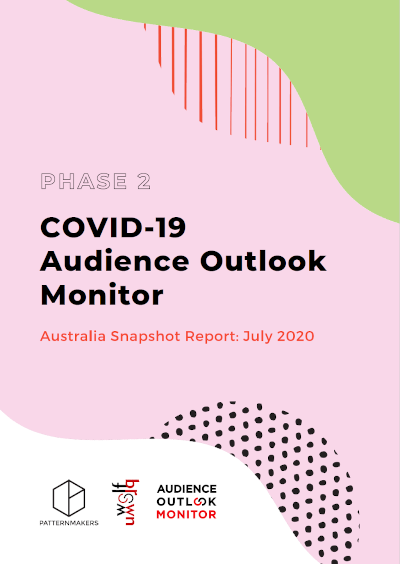Karina Utomo performs in the 2019 Perth Festival production of Cat Hope’s Speechless, produced by Tura New Music. Credit: Toni Wilkinson.
COVID-19 Audience Outlook Monitor, Australia Council for the Arts, 18 May 2020
COVID-19 Audience Outlook Monitor webinars

Download the May 2020 Snapshot Report
Download the July 2020 Snapshot Report
Explore the dashboard
About Audience Outlook Monitor Australia
Findings from Phase 2 will be discussed in an upcoming webinar on Wednesday 29 July. The Phase 1 webinar series explored different topics within the Audience Outlook Monitor by digging deeper into the results with industry experts.
The Australia Council is working with Patternmakers and WolfBrown to understand changes in behaviours and sentiments of arts-goers in the wake of the COVID-19 pandemic, to support decision-making and forward planning across the sector.
Restrictions on public gatherings and travel have forced many in the arts community to shut their doors and cancel programs and activities. This tracking study is designed to support important decision-making in the coming months about when to open again and resume programming in spaces where people physically gather.
The Audience Outlook Monitor provides artists, cultural organisations and the broader arts sector with valuable information as changes occur.
Results from the second phase of the study are now available, with the key insights outlined in the July Snapshot Report. The final data collection phase is planned for September 2020.
All data is available in the Audience Outlook Monitor dashboard, with results from over 23,000 respondents in Phase 1 and over 15,000 respondents in Phase 2.
Key findings from the second phase include:
- Audiences are increasingly ready to return to attend cultural events in most locations as soon as permitted (28%, up from 22% in May).
- One in four past attendees have started returning to cultural events (24%) with museums and galleries (12%) and cinemas (9%) the most common venues.
- Audiences are increasingly comfortable to attend performance venues of all sizes, assuming they were open, following safety procedures and observing social distancing guidelines.
- One in ten people had bought a ticket for live show or performance, with lead times becoming shorter as most ticketholders buying tickets less than one month out.
- Four in ten people would prefer a digital program rather than attending in person right now (39%).
- Some audiences are feeling more pessimistic about returning to events long-term, with almost a quarter saying their future attendance will be negatively affected (22%, up from 15% in May).
- Most people expect to spend the same on arts and culture events as they did before (72%), but one in five expect to spend less (15%).
- Audiences remain engaged with creative activities at home like listening to music (89%) and reading for pleasure (86%). Three in four are participating in online cultural experiences (73%) consistent with findings in May.
- Slightly more people are paying for online experiences (36%, up from 34% in May), and they are spending more with almost two in five having spent more than $50 in the past fortnight.
About the study
The Audience Outlook Monitor captures ‘active’ arts audiences – those who are on the contact database of at least one of the 159 participating organisations and have attended a cultural event since January 2018 – rather than the general population. The results will be most relevant for activities that rely on people being in public spaces, similar to those of the 159 participating museums, galleries, festivals and organisations.
Baseline data for this tracking study was collected in a cross-sector collaborative survey process involving 159 arts and culture organisations, including museums, galleries, performing arts organisations and festivals. These organisations simultaneously sent a survey to a random sample of their audiences, who had attended a cultural event since January 2018.
The responses span a diverse range of event types and encompass people who attend all types of events. The large sample provides detailed insights about different art forms, types of events, demographic groups and parts of Australia.
Read more about the methodology and the types of events which are included.
Delivery Partners
List of participating organisations

